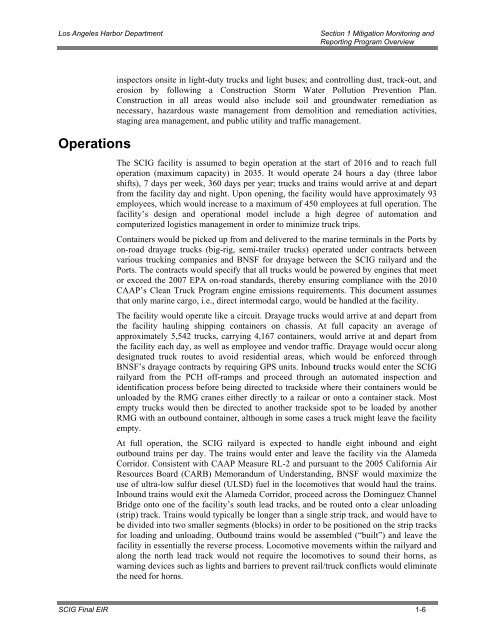Final Mitigation Monitoring and Reporting Program (MMRP)
Final Mitigation Monitoring and Reporting Program (MMRP)
Final Mitigation Monitoring and Reporting Program (MMRP)
Create successful ePaper yourself
Turn your PDF publications into a flip-book with our unique Google optimized e-Paper software.
Los Angeles Harbor Department<br />
Section 1 <strong>Mitigation</strong> <strong>Monitoring</strong> <strong>and</strong><br />
<strong>Reporting</strong> <strong>Program</strong> Overview<br />
Operations<br />
inspectors onsite in light-duty trucks <strong>and</strong> light buses; <strong>and</strong> controlling dust, track-out, <strong>and</strong><br />
erosion by following a Construction Storm Water Pollution Prevention Plan.<br />
Construction in all areas would also include soil <strong>and</strong> groundwater remediation as<br />
necessary, hazardous waste management from demolition <strong>and</strong> remediation activities,<br />
staging area management, <strong>and</strong> public utility <strong>and</strong> traffic management.<br />
The SCIG facility is assumed to begin operation at the start of 2016 <strong>and</strong> to reach full<br />
operation (maximum capacity) in 2035. It would operate 24 hours a day (three labor<br />
shifts), 7 days per week, 360 days per year; trucks <strong>and</strong> trains would arrive at <strong>and</strong> depart<br />
from the facility day <strong>and</strong> night. Upon opening, the facility would have approximately 93<br />
employees, which would increase to a maximum of 450 employees at full operation. The<br />
facility’s design <strong>and</strong> operational model include a high degree of automation <strong>and</strong><br />
computerized logistics management in order to minimize truck trips.<br />
Containers would be picked up from <strong>and</strong> delivered to the marine terminals in the Ports by<br />
on-road drayage trucks (big-rig, semi-trailer trucks) operated under contracts between<br />
various trucking companies <strong>and</strong> BNSF for drayage between the SCIG railyard <strong>and</strong> the<br />
Ports. The contracts would specify that all trucks would be powered by engines that meet<br />
or exceed the 2007 EPA on-road st<strong>and</strong>ards, thereby ensuring compliance with the 2010<br />
CAAP’s Clean Truck <strong>Program</strong> engine emissions requirements. This document assumes<br />
that only marine cargo, i.e., direct intermodal cargo, would be h<strong>and</strong>led at the facility.<br />
The facility would operate like a circuit. Drayage trucks would arrive at <strong>and</strong> depart from<br />
the facility hauling shipping containers on chassis. At full capacity an average of<br />
approximately 5,542 trucks, carrying 4,167 containers, would arrive at <strong>and</strong> depart from<br />
the facility each day, as well as employee <strong>and</strong> vendor traffic. Drayage would occur along<br />
designated truck routes to avoid residential areas, which would be enforced through<br />
BNSF’s drayage contracts by requiring GPS units. Inbound trucks would enter the SCIG<br />
railyard from the PCH off-ramps <strong>and</strong> proceed through an automated inspection <strong>and</strong><br />
identification process before being directed to trackside where their containers would be<br />
unloaded by the RMG cranes either directly to a railcar or onto a container stack. Most<br />
empty trucks would then be directed to another trackside spot to be loaded by another<br />
RMG with an outbound container, although in some cases a truck might leave the facility<br />
empty.<br />
At full operation, the SCIG railyard is expected to h<strong>and</strong>le eight inbound <strong>and</strong> eight<br />
outbound trains per day. The trains would enter <strong>and</strong> leave the facility via the Alameda<br />
Corridor. Consistent with CAAP Measure RL-2 <strong>and</strong> pursuant to the 2005 California Air<br />
Resources Board (CARB) Memor<strong>and</strong>um of Underst<strong>and</strong>ing, BNSF would maximize the<br />
use of ultra-low sulfur diesel (ULSD) fuel in the locomotives that would haul the trains.<br />
Inbound trains would exit the Alameda Corridor, proceed across the Dominguez Channel<br />
Bridge onto one of the facility’s south lead tracks, <strong>and</strong> be routed onto a clear unloading<br />
(strip) track. Trains would typically be longer than a single strip track, <strong>and</strong> would have to<br />
be divided into two smaller segments (blocks) in order to be positioned on the strip tracks<br />
for loading <strong>and</strong> unloading. Outbound trains would be assembled (“built”) <strong>and</strong> leave the<br />
facility in essentially the reverse process. Locomotive movements within the railyard <strong>and</strong><br />
along the north lead track would not require the locomotives to sound their horns, as<br />
warning devices such as lights <strong>and</strong> barriers to prevent rail/truck conflicts would eliminate<br />
the need for horns.<br />
SCIG <strong>Final</strong> EIR 1-6
















